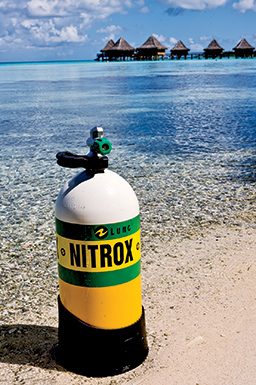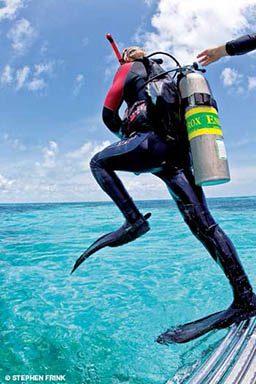Like many new things, when enriched air, or nitrox, was first introduced to the recreational diving community, it was met with a healthy dose of skepticism. Concerns about its viability, its use and divers’ safety while breathing it created myths and misconceptions about “voodoo gas” that are still heard today. Despite the supernatural nickname, nitrox has increasingly gained acceptance since its adoption by recreational divers, as it proved to be not a magical potion, but a valuable tool for those who know how to use it.
Who Invented It?
Many think of nitrox and other mixed gases as relatively new, since they have been used in the recreational diving community for only the last 20 years or so. But nitrox has actually been around and in use for several decades. Both the U.S. Navy and commercial diving companies have employed it since the 1950s.
In the late 1970s J. Morgan Wells, then the director of the National Oceanic and Atmospheric Administration (NOAA) diving program, proposed procedures for diving with oxygen-enriched air and creating a breathing gas mix known as NOAA Nitrox 1, or NN32, named for the percentage of oxygen in the mix. The gas mix was developed based on two criteria: a maximum operating depth of 130 feet and a maximum oxygen partial pressure of 1.6 atmospheres absolute (ATA). For years, the NOAA guidelines were the standard when it came to enriched air. In 1985 Dick Rutkowski, retired NOAA diving program training director, developed the first nitrox training program for the recreational diver.

How Is Nitrox Made?
Simply stated, nitrox is made by either combining or separating gases. While this might sound contradictory, it’s really just a matter of method. The two most common methods for manufacturing nitrox are partial pressure blending and the membrane method.
Partial pressure blending adds small, controlled quantities of pure oxygen to compressed air to achieve the desired mix. This is much like adding small quantities of very hot water into a stream of cold water to achieve warm water. It takes good control, but done properly it can be effective. The membrane, or gas separation, method employs a semipermeable membrane to separate the nitrogen from air, creating a breathing gas with elevated oxygen content. Both systems achieve the same result: a breathing gas with a concentration of oxygen higher than the normal 21 percent and a concentration of nitrogen lower than the normal 78 percent.
Not for Deeper Depths
While it is less common to hear today, when nitrox was first introduced to the diving public it had the reputation as a “deep diving” gas. Ironically, exactly the opposite is true. Because of the elevated oxygen levels, there are maximum operating depth (MOD) limits on nitrox. Exceed those depth limits and the risk of seizure from central nervous system oxygen toxicity is too high.
Dalton’s law states that the total pressure of a gas is equal to the sum of the pressures of its component gases. MOD limits are predicated on maximum partial pressures, the pressures exerted by specific component gases. While the percentage of any component within a gas mix doesn’t change during a dive, the pressure exerted on it does as a function of depth. The recreational scuba community generally recommends a maximum oxygen partial pressure of 1.4 ATA; this is exceeded on air at approximately 198 feet, but when the composition of the breathing gas is changed, adjusted MODs are needed. Based on the 1.4 ATA limit, a nitrox mix with 32 percent oxygen has an MOD of 112 feet, and 36-percent nitrox has a maximum depth of 95 feet.
Why Use it?
Given the role nitrogen plays in certain concerns for divers, including nitrogen narcosis and decompression sickness (DCS), it’s easy to see why reducing one’s exposure to it might be appealing. By reducing the amount of nitrogen in the breathing gas and replacing it with a gas the body metabolizes anyway, nitrox can lower the risk of DCS or even safely extend a diver’s bottom time, but it’s important to realize both cannot be done at the same time.
The decreased risk of DCS comes from a fairly simple concept: By reducing the amount of nitrogen in the gas mix, the diver absorbs less nitrogen into his tissues. Compared to the risk the diver would face diving the same profile on air, DCS risk is lower using nitrox, though the risk is not eliminated completely. To take advantage of the increased safety margin, divers can simply plan a dive as though using air and execute the dive using nitrox, though the MOD of the actual gas mix used must be observed.

Increased bottom time comes from the equivalent air depth (EAD) principle. Dive tables and computers calculate no-decompression limits using the partial pressure of nitrogen in breathing gas. When the percentage of nitrogen (and as a result, its partial pressure) is reduced, this provides the equivalent of breathing regular air at a shallower depth. In other words, you can dive at a given depth on nitrox with the physiological consequences of diving at a shallower depth on air; diving 32-percent nitrox at 110 feet is equivalent to diving air at 90 feet. So when calculating dive times using a dive table or dive computer, a diver can calculate the dive as if it is to a shallower depth, thereby extending bottom time.
Conclusions
Today, nitrox mixes are readily available and prepared across a range of concentrations. It has a lot to offer divers, but it isn’t magic; rather, it’s a useful tool that provides benefits if used correctly. When diving according to air tables or using the air setting on a dive computer, nitrox can reduce decompression stress on a diver. When used with an equivalent air depth, this safety margin is lost, but bottom time can be extended.
Nitrox is becoming more popular and accessible to recreational divers all the time, but it is not something to be taken lightly. It requires special training to be used properly and safely, so before you dive with it, be sure to get the necessary training and gain the appropriate certification.
How Do You Know It’s Nitrox?
Scuba tanks filled with nitrox are designated with nitrox decals, along with labels noting the mixture contained in the tank. EAN32 is nitrox with a 32 percent oxygen concentration, EAN36 contains a mixture of 36 percent oxygen and so on.
© Alert Diver — Q4 Fall 2011